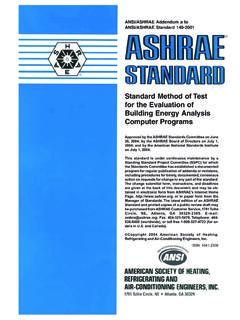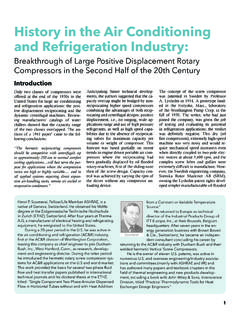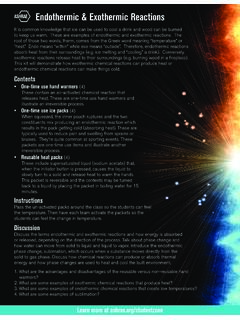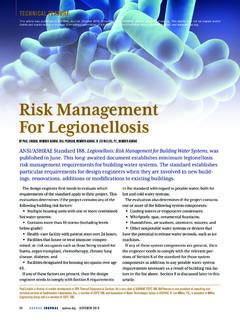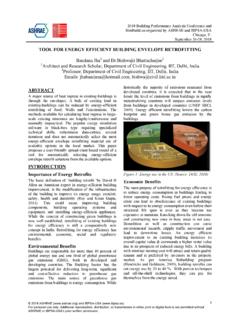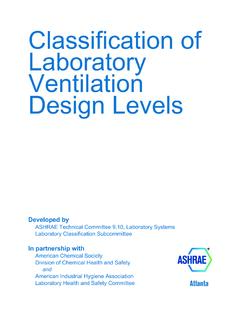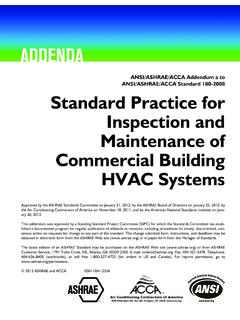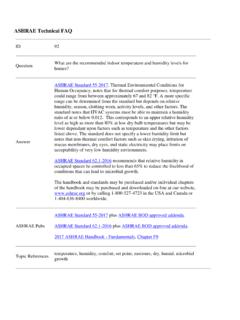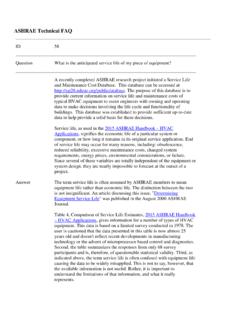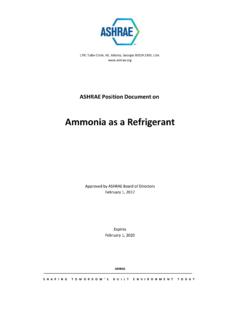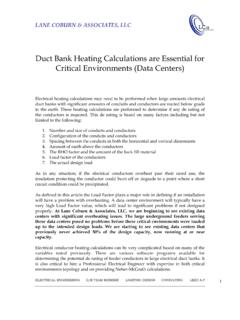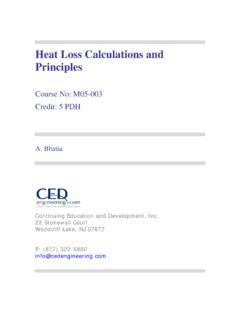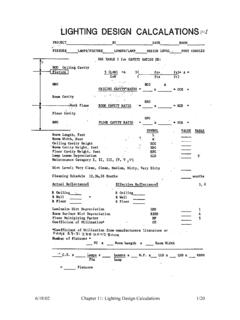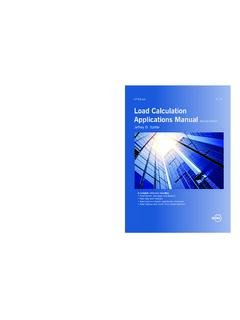Transcription of Ventilation for Acceptable Indoor Air Quality - ASHRAE
1 ANSI/ ASHRAE Addendum n toANSI/ ASHRAE Standard 62-2001 Ventilation forAcceptableIndoor Air QualityApproved by the ASHRAE Standards Committee on June 28, 2003;by the ASHRAE Board of Directors on July 3, 2003; and by theAmerican National Standards Institute on January 8, standard is under continuous maintenance by a StandingStandard Project Committee (SSPC) for which the StandardsCommittee has established a documented program for regularpublication of addenda or revisions, including procedures fortimely, documented, consensus action on requests for change toany part of the standard. The change submittal form, instruc-tions, and deadlines may be obtained in electronic form from theASHRAE web site, , or in paper form fromthe Manager of Standards. The latest edition of an ASHRAE Stan-dard and printed copies of a public review draft may be pur-chased from ASHRAE Customer Service, 1791 Tullie Circle, NE,Atlanta, GA 30329-2305.
2 E-mail: Fax: 404-321-5478. Telephone: 404-636-8400 (worldwide), or toll free 1-800-527-4723 (for orders in and Canada). Copyright 2003 American Society of heating ,Refrigerating and Air-Conditioning Engineers, 1041-2336 SPECIAL NOTEThis American National Standard (ANS) is a national voluntary consensus standard developed under the auspices of the AmericanSociety of heating , Refrigerating and Air-Conditioning Engineers ( ASHRAE ). Consensus is defined by the American National StandardsInstitute (ANSI), of which ASHRAE is a member and which has approved this standard as an ANS, as substantial agreement reachedby directly and materially affected interest categories. This signifies the concurrence of more than a simple majority, but not necessarilyunanimity. Consensus requires that all views and objections be considered, and that an effort be made toward their resolution. Compliance with this standard is voluntary until and unless a legal jurisdiction makes compliance mandatory through obtains consensus through participation of its national and international members, associated societies, and Standards are prepared by a Project Committee appointed specifically for the purpose of writing the Standard.
3 TheProject Committee Chair and Vice-Chair must be members of ASHRAE ; while other committee members may or may not be ASHRAE members, all must be technically qualified in the subject area of the Standard. Every effort is made to balance the concerned interestson all Project Committees. The Manager of Standards of ASHRAE should be contacted for:a. interpretation of the contents of this Standard,b. participation in the next review of the Standard,c. offering constructive criticism for improving the Standard,d. permission to reprint portions of the INDUSTRIAL ADVERTISING POLICY ON STANDARDSASHRAE Standards and Guidelines are established to assist industry and the public by offering a uniform method of testing for rating purposes, by suggesting safe practices in designing and installing equipment, by providing proper definitions of this equipment, and by providing other information that may serve to guide the industry. The creation of ASHRAE Standards and Guidelines is determined by the need for them, and conformance to them is completely referring to this Standard or Guideline and in marking of equipment and in advertising, no claim shall be made, eitherstated or implied, that the product has been approved by uses its best efforts to promulgate Standards and Guidelines for the benefit of the public in light of availableinformation and accepted industry practices.
4 However, ASHRAE does not guarantee, certify, or assure the safety orperformance of any products, components, or systems tested, installed, or operated in accordance with ASHRAE s Standardsor Guidelines or that any tests conducted under its Standards or Guidelines will be nonhazardous or free from STANDARDS COMMITTEE 2002-2003 Thomas E. Watson, ChairVan D. Baxter, Vice-ChairCharles G. ArnoldDean S. BorgesPaul W. CabotCharles W. Coward, P. DoughertyHakim ElmahdyArthur D. HallstromMatt R. HarganRichard D. HermansStephen D. KennedyDavid E. KnebelFrederick H. KohlossWilliam J. LandmanMerle F. McBrideRoss D. MontgomeryCyrus H. NasseriDavor NovoselDennis A. StankeMichael H. TavaresSteven T. TaylorDavid R. TreeTerry E. Townsend, COMaureen Grasso, ExOClaire B. Ramspeck, Manager of StandardsASHRAE Standard Project Committee Cognizant TC: TC , Ventilation Requirements and InfiltrationSPLS Liaison: Fredrick H. KohlossAndrew K. Persily, Chair*David S. Bulter, Sr.
5 , Vice-Chair*Leon E. Alevantis*Michael BeatonLynn G. BellengerHoy R. Bohanon, Jr. *Dale J. CagwinJames L. Coggins*Elissa Feldman*Francis J. Fisher, Jr.*Francis Michael GalloScott Douglas Hanson*Roger L. HedrickThomas P. Houston*Eli P. Howard, III*Ralph T. JoeckelDonald G. Koch*Carl A. Marbery*Bernice A. Mattsson*John K. McFarlandChristopher O. Muller*Guillermo A. NavasJohn E. Osborn*R. Dean Rasmussen*Walter L. Raynaud*Lisa J. RogersRobert S. Rushing*Lawrence J. SchoenDennis A. StankeJan Sundell*Terry Lee SutherlandWayne ThomannJames A. TshudyDilip Y. Vyavaharkar*David R. WardenMichael W. Woodford**Denotes members of voting status when the document was approved for publicationAddendum n to ANSI/ ASHRAE STANDARD 62-20011(This foreword is not part of this standard. It is merelyinformative and does not contain requirements necessaryfor conformance to the standard. It has not been pro-cessed according to the ANSI requirements for a stan-dard and may contain material that has not been subjectto public review or a consensus process.)
6 Foreword to Addendum 62nThis addendum revises the Ventilation Rate Procedurecurrently contained in Section of ANSI/ ASHRAE Standard62-2001. This revision was developed as part of the effort toconvert the entire standard to mandatory, enforceable lan-guage suitable for adoption into building codes and to reflectnew technical information that has become available since thecurrent Ventilation Rate Procedure was prepared in the mid-1980s. The Ventilation Rate Procedure in Standard 62-2001 isessentially identical to the version in the 1989 standard andcontains a number of requirements that run counter to the cur-rent objectives of minimum requirements and mandatory,enforceable language. For example, the current standard spec-ifies outdoor air requirements in the breathing zone, whichare very difficult to actually measure and therefore to also requires one to account for air mixing in ventilatedspaces when determining outdoor air rates but provides nospecific calculation approach for doing so.
7 Standard 62 alsorequires the use of the so-called multiple spaces equation toadjust outdoor air rates for recirculating systems that servemore than one room. However, this equation is seldom used bydesigners (possibly due to its perceived complexity) and, aspresented in the current standard, does not apply to manycommon system revision in this addendum addresses these issuesrelated to the objective of code-intended language in a numberof ways. It specifies the determination of design ventilationrates that can be easily measured so that compliance can beverified, both by review of the design documents and by fieldmeasurement. It does this by relating the Ventilation require-ments in the breathing zone to the outdoor air intake rate atthe air-handling system, a quantity that is more readily mea-sured using standard airflow measurement techniques as spec-ified in ASHRAE Standard 111. In this revision, room mixingis addressed explicitly in the calculation of Ventilation rates,with default values for the air change effectiveness provided tofacilitate the application of this adjustment.
8 In addition, multi-ple space calculations have been greatly simplified for thebulk of design applications, with a more detailed approachavailable for those who choose to use the Ventilation requirements themselves, mostof them have been decreased relative to the 1989/2001 versionof the standard. However, with the explicit requirement toaccount for room mixing and Ventilation system efficiency, thetotal outdoor airflow rate at the air intake will not changemuch in most systems. The most significant changes in theventilation requirements occur in densely occupied spaces,such as conference rooms and auditoria, requirements thathad been strongly criticized as being much higher thanneeded. Furthermore, since the standard is now focused onminimum requirements, the Ventilation rate requirements arebased on that focus as opposed to the 1989 standard, whichwas not. Also, in recognition of the fact that Indoor air pollut-ants are generated by both building occupants (and theiractivities) as well as by the contents of a building, the ventila-tion requirements include both a people component (to dilutecontaminants from people and their activities) and an areacomponent (to dilute contaminants from non-occupant-relatedsources that are more related to floor area than the number ofpeople).
9 The Ventilation requirements for a particular spacebased on people and on floor area are then added together todetermine the total Ventilation requirement for a space. Whileacknowledging that the additivity approach does not applyto all aspects of Indoor air Quality , the committee believes thatadditivity is the predominant effect when considering multiplecontaminant sources that impact occupant perception withrespect to odor and irritation. While important questionsremain regarding additivity, the majority of research data sup-port its use in this first public review of addendum 62n occurred in 1999and produced about 70 unique comments. Of these, about halfcalled for increased Ventilation rates, while a smaller numbersuggested further decreases. About 10% of the commentsaddressed the issue of complexity, and these were evenly splitbetween complaints about too much complexity and requestsfor more detail. About one-third commented on the additivemethodology for combining the Ventilation requirementsbased on the number of people with the requirements based onfloor area, but the committee retained this approach based onthe principles discussed above and the ability to explicitlyadjust Ventilation rates based on occupant density.
10 In responseto many of the public review comments, a full second publicdraft was developed and issued for comment. In this draft,some of the Ventilation requirements were increased (mostnotably in educational buildings) relative to the first publicreview draft. A number of changes were also made to addressthe concerns of complexity, including the removal of a require-ment for minimum supply airflow rates and a number ofchanges in the language and second public review resulted in about 80 uniquecomments, most of which addressed the same issues identifiedin the first public review. As a result, a limited number ofchanges were issued for a third public review, including arevised definition of zone, simplified approaches for deter-mining outdoor air intake rates for single-zone and 100% out-door air systems, revision of the tables of default values ofzone and system Ventilation efficiencies, and a revision of thenormative appendix that presents a more detailed methodol-ogy for determining system Ventilation efficiencies.
